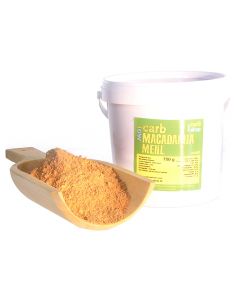Flours for low-carb cooking and baking
Except for the functional flours wheat gluten, psyllium husk flour, chia flour, and both flaxseed flours, all of our other flours are almost 100% interchangeable. For example, almond flour can be fully or partially replaced with sunflower or Brazil nut flour in almost all recipes.
Another exception is lupin flour, which tastes great, but if consumed in excess (> 30g per day) can cause unpleasant bloating due to the inulin it contains. All other flours can be combined and interchanged as desired. It's purely a matter of taste. Only the amount of water might vary slightly; the fibers in particular are extremely absorbent.
Regular wheat flour contains 12-15% gluten, and this should also be taken into account when adding wheat gluten to a dough, as this – activated by kneading for about 10 minutes – is responsible for the consistency, structure, and rise of the dough.
15% of our wheat gluten is therefore the rule for bread dough. If you use less, the result will be crumbly and won't rise (some cookies require that). More makes the dough firmer (we once tried cheese sticks made only with cheese and wheat gluten. They were delicious straight out of the oven. After an hour, even our dog had trouble chewing them.)
The three other flours mentioned above can be substituted for wheat gluten. As a rule of thumb: For psyllium flour, use half the amount of wheat gluten, and for chia flour, use double the amount. If you add more than 60% flaxseed flour to a dough, you don't need any more wheat gluten.
If you're particularly good at math (after some experience, you'll also be able to do it by feel), you can also combine these functional flours. For example, if you add 30% flaxseed to bread dough, you can use half the amount of wheat gluten.
You can find many tested recipes on our recipe page www.delicious-low-carb.com
-

-

-

-
 -Carb ALMOND FLOUR CLASSIC (de-oiled) 500g€7.50Incl. 7% VAT zzgl. VersandkostenPreis per 1 kg€15.00
-Carb ALMOND FLOUR CLASSIC (de-oiled) 500g€7.50Incl. 7% VAT zzgl. VersandkostenPreis per 1 kg€15.00 -

-

-
 -Carb GOLD Flaxseed flour (de-oiled) 750g€7.50Incl. 7% VAT zzgl. VersandkostenPreis per 1 kg€10.00
-Carb GOLD Flaxseed flour (de-oiled) 750g€7.50Incl. 7% VAT zzgl. VersandkostenPreis per 1 kg€10.00 -

-

-

-
 -Carb PSYLIUM HUSK (finely ground) 750g€13.90Incl. 7% VAT zzgl. VersandkostenPreis per 1 kg€17.20
-Carb PSYLIUM HUSK (finely ground) 750g€13.90Incl. 7% VAT zzgl. VersandkostenPreis per 1 kg€17.20 -

-
 -Carb MACADAMIA flour (partially de-oiled) 750 g€12.90Incl. 7% VAT zzgl. VersandkostenPreis per 1 kg€17.20
-Carb MACADAMIA flour (partially de-oiled) 750 g€12.90Incl. 7% VAT zzgl. VersandkostenPreis per 1 kg€17.20 -

-
 -Carb PUMPKIN SEED FLOUR (de-oiled) 750 g€5.90Incl. 7% VAT zzgl. VersandkostenPreis per 1 kg€7.86
-Carb PUMPKIN SEED FLOUR (de-oiled) 750 g€5.90Incl. 7% VAT zzgl. VersandkostenPreis per 1 kg€7.86 -

-

-


